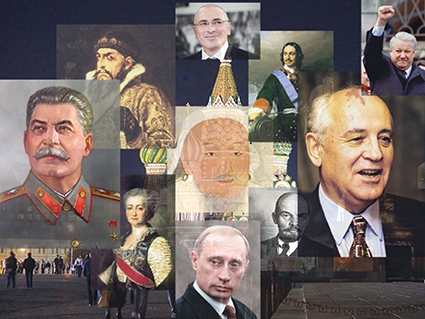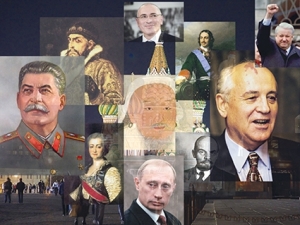What History Teaches Us About Modern Russia
Historical comparisons are necessary when analyzing current political realities. Examples may at times be misleading and the author should be careful when highlighting particular historical developments, yet Russian history is arguably one of those stories where recurrent cycles have been seen throughout the last several centuries.
A constant feature has been the country rising from chaos, returning as a regional and sometimes even global power, then aspiring to consolidate its gains through strong-hand rule and the addition of neighboring territories before the entire system collapses. Then comes a new cycle.
One of the constants of that fateful historical cycle is the country’s geography. Russia is big, spanning almost the entire northern Eurasian landmass. However, behind this immense land is hidden the fact that more than half the country is non-navigable (as major rivers fall into the Northern Ocean) and the climate harsh enough to hinder any meaningful agricultural works beyond the Ural Mountains.
What is central, though, is Russia's heartland running from St. Petersburg and the Finnish border southwards to the Black and Caspian seas. This heartland is essentially a series of plains, quite vulnerable from all sides. Indeed, Mongol and other nomadic peoples’ invasions from the east in the Middle Ages, as well as European conquerors’ onslaughts from the west in the modern period, has forced Russia to try to expand its borders and influence outward to create buffer zones between its heartland and rival regional powers in Europe and the Middle East.
To contain this immense geographic sphere, the Russian leaders have had to expend immense financial, military and political resources. Moscow centralized control over its heartland and the surrounding territories, subsidizing the economies of most of the incorporated territories at the same time as managing their diverse populations. This forcible drive to expansion (in order to survive), though successful for a short period, proved to be unsustainable in the long-run.
Historical cycles in Russia usually begin with a national catastrophe. Sometimes it comes as a result of internal havoc, sometimes it has followed foreign threat. The end result has always been the dissolution of the existing order and ensuing chaos. After the collapse comes resurrection: usually the system that governed during the crisis is transformed into something new when a strong figure appears. The new leading figure creates a stable system and reoccupies both the Russian heartland and the borderlands. New paradigms for the unified Russian space and all the various nations living there are then created to heighten the sense of national identity among both Russians and non-Russians.
There were three cases in Russian history which prove that the country regularly experiences this developmental pattern which, rooted in Russia’s geography, is to be seen again, now, in the early 21st century, under the rule of Vladimir Putin.
In the late 17th-early 18th century, Russia experienced a long period of chaos with the old Rurik dynasty’s rule in a shambles and state structures experiencing deep troubles. Army, administration as well as personal fidelity links were weakened or totally destroyed. The chaos was decade-long, and the result was a restructuring: a new dynasty headed by Mikhail Romanov I. A new project for the Russian Empire (in everything but name) was born. The new dynasty set out to incorporate borderlands and compete with regional powers, ending the troubles.
In the 20th century, the Russian Revolution caused the downfall of the Romanov dynasty and ushered in a period of civil war and chaos where the Bolsheviks managed to build a powerful base to re-create a fallen Russian Empire, albeit on a different ideological basis. Lenin and Stalin set out to re-incorporate borderlands and re-shape ethnic understanding within the newly created Soviet Union. Control over large territories then came under stress as large resources were spent on exercising control over rather than producing enough for the population. The result was an over extension of the Soviet power.
Then that pattern again: the Soviet Union collapsed and the ensuing military and social chaos was topped by the 1998 financial crisis. Attempts to transition to a market economy led to radical privatization and the rise of oligarchs, which in turn resulted in a nearly 40% decline in GDP. Numerous parties emerged with very different agendas. The security services and military were weakened, while the Russian people struggled to find a new identity to unite under. Secession attempts in some of Russia's regions led to wars, most notably in Chechnya.
As borderlands again rioted against the Russian heartland and so did some territories of Russia proper, it was logical that a Russian resurgence of some sort would happen under a new figure (like Mikhail I, Lenin and Stalin). Indeed, under Vladimir Putin, prosperity set in. Russia is strong militarily. Its economy, although under huge duress from both internal and foreign factors, is still in much better shape than it was in the 1990s. Quite logically, Putin, like his predecessors mentioned above, set out to regain the borderlands. War with Georgia, conflict in Ukraine, support for secessionist regimes across the former Soviet Union as well as the unveiling of the Eurasian Economic Union, are some of his major moves to reshape Russia and return her to the club of major global powers.
The rise and success of the Putin government falls within Russia's historical cycle. He plays the role of savior on par with Mikhail I and Lenin. However, as stated at the beginning, although historical comparisons need to be made, one also needs to be careful not to overestimate some similarities.
True, Putin falls within this historical cycle and, according to it, Russia should now be very close to its military and economic preeminence as under the first Romanov and Soviet leaders. It is also true that Putin is popular and is unlikely to face a real challenger inside Russia. Nevertheless, his rule shows some signs of fundamental weakness. Like his predecessors, Putin faces Russia's perennial problem: geography. The aggravating trend here is that in Putin’s case, Russia’s geographic challenge seems to be more problematic. NATO and the European Union are expanding their influence in Eastern Europe and the former Soviet space; China is growing its military and economic power in Central Asia (yet another in Moscow’s backyard); economic problems are serious as western resolve to keep and even increase sanctions against Russia sees no sign of abating. Moreover, unlike the Romanovs or the Soviets, the Putin government does not possess an ideological tool. His Eurasian concept might be tempting but has no real economic essence as too many important states across the post Soviet space do not want to join.
In conclusion, it can be argued that historical parallels work but they fail too. Putin indeed falls into the Russian historical cycle of the rise and fall of the Russian state seen over the centuries. But there are crucial differences too that for the near future will refuse his government some fundamental successes as he seeks to transform the country into a real global power.
By Emil Avdaliani












